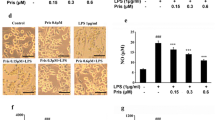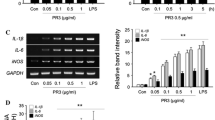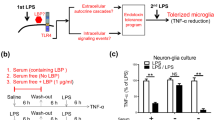Abstract
Microglia (MG) are resident phagocytes in the brain responsible for neuronal maintenance. The regulation of MG necroptosis is required for protecting neurons during neurodegenerative diseases. Therefore, this study proposed to elucidate the molecular mechanisms underlying microglia necroptosis during long-time apoptotic stimuli (lipopolysaccharide, LPS). The protective role of plasmalogens (PLS) was also investigated against LPS insult in MG cells (including BV2 and MG6 cell lines). LPS produced time-dependent decreases in the survival of BV2 and MG6 cells mediated by the caspase signaling pathway. Interestingly, MG death was mediated by caspase-8 and 9 signaling pathways suggesting that MG necroptosis was actively attributed to long-time LPS treatment through intrinsic and extrinsic pathways. Notably, caspase signaling was markedly inhibited in the PLS-pretreated cells; thereby, PLS were capable of maintaining the MG cell population and inhibit the MG necroptosis against the longtime of LPS administration via its antioxidant and anti-inflammatory properties.
Graphical abstract











Similar content being viewed by others
Data Availability
The data used to support the findings of this study are available from the corresponding authors upon request.
References
Abdeen A, Abdelkader A, Elgazzar D, Aboubakr M, Abdulah OA, Shoghy K, Abdel-Daim M, el-Serehy HA, Najda A, el-Mleeh A (2020) Coenzyme Q10 supplementation mitigates piroxicam-induced oxidative injury and apoptotic pathways in the stomach, liver, and kidney. Biomed Pharmacother 130:110627. https://doi.org/10.1016/j.biopha.2020.110627
Ali F, Hossain MS, Sejimo S, Akashi K (2019) Plasmalogens inhibit endocytosis of toll-like receptor 4 to attenuate the inflammatory signal in microglial cells. Mol Neurobiol 56:3404–3419. https://doi.org/10.1007/s12035-018-1307-2
Burguillos MA, Deierborg T, Kavanagh E, Persson A, Hajji N, Garcia-Quintanilla A, Cano J, Brundin P, Englund E, Venero JL, Joseph B (2011) Caspase signalling controls microglia activation and neurotoxicity. Nature 472:319–324. https://doi.org/10.1038/nature09788
Caccamo A, Branca C, Piras IS, Ferreira E, Huentelman MJ, Liang WS, Readhead B, Dudley JT, Spangenberg EE, Green KN, Belfiore R, Winslow W, Oddo S (2017) Necroptosis activation in Alzheimer’s disease. Nat Neurosci 20:1236–1246. https://doi.org/10.1038/nn.4608
Colonna M, Butovsky O (2017) Microglia function in the central nervous system during health and neurodegeneration. Annu Rev Immunol 10:441–468. https://doi.org/10.1146/annurev-immunol-051116-052358
Elkin ER, Harris SM, Loch-Caruso R (2018) Trichloroethylene metabolite S-(1,2-dichlorovinyl)-L-cysteine induces lipid peroxidation-associated apoptosis via the intrinsic and extrinsic apoptosis pathways in a first-trimester placental cell line. Toxicol Appl Pharmacol 338:30–42. https://doi.org/10.1016/j.taap.2017.11.006
Fan H, Zhang K, Shan L, Kuang F, Chen K, Zhu K, Ma H, Ju G, Wang YZ (2016) Reactive astrocytes undergo M1 microglia/macrohpages-induced necroptosis in spinal cord injury. Mol Neurodegener 11:1–16. https://doi.org/10.1186/s13024-016-0081-8
Fujino T, Yamada T, Asada T et al (2017) Efficacy and blood plasmalogen changes by oral administration of plasmalogen in patients with mild Alzheimer’s disease and mild cognitive impairment: a multicenter, randomized, double-blind, placebo-controlled. EBioMedicine 17:199–205. https://doi.org/10.1016/j.ebiom.2017.02.012
Fujino T, Hossain MS, Mawatari S (2020) Peroxisome biology: experimental models, peroxisomal disorders and neurological diseases. Springer Nature, Switzerland
Fulda S (2009) Apoptosis pathways and neuroblastoma therapy. Curr Pharm Des 15:430–435. https://doi.org/10.2174/138161209787315846
Gomez-Nicola D, Perry VH (2015) Microglial dynamics and role in the healthy and diseased brain: a paradigm of functional plasticity. Neuroscientist 21:169–184. https://doi.org/10.1177/1073858414530512
Heneka MT (2017) Inflammasome activation and innate immunity in Alzheimer’s disease. Brain Pathol 27:220–222. https://doi.org/10.1111/bpa.12483
Hossain MS, Ifuku M, Take S et al (2013) Plasmalogens rescue neuronal cell death through an activation of AKT and ERK survival signaling. PLoS One 8:1–14. https://doi.org/10.1371/journal.pone.0083508
Hristovska I, Pascual O (2016) Deciphering resting microglial morphology and process motility from a synaptic prospect. Front Integr Neurosci 9:1–7. https://doi.org/10.3389/fnint.2015.00073
Hu L, Su C, Song X, Shi Q, Fu J, Xia X, Xu D, Song E, Song Y (2015) Tetrachlorobenzoquinone triggers the cleavage of Bid and promotes the cross-talk of extrinsic and intrinsic apoptotic signalings in pheochromocytoma (PC) 12 cells. Neurotoxicology 49:149–157. https://doi.org/10.1016/j.neuro.2015.06.005
Huang Z, Zhou T, Sun X, Zheng Y, Cheng B, Li M, Liu X, He C (2018) Necroptosis in microglia contributes to neuroinflammation and retinal degeneration through TLR4 activation. Cell Death Differ 25:180–189. https://doi.org/10.1038/cdd.2017.141
Julien O, Wells JA (2017) Caspases and their substrates. Cell Death Differ 24:1380–1389. https://doi.org/10.1038/cdd.2017.44
Lemmers B, Salmena L, Bidère N, Su H, Matysiak-Zablocki E, Murakami K, Ohashi PS, Jurisicova A, Lenardo M, Hakem R, Hakem A (2007) Essential role for caspase-8 in toll-like receptors and NFκB signaling. J Biol Chem 282:7416–7423. https://doi.org/10.1074/jbc.M606721200
Luo Q, Yan X, Bobrovskaya L, Ji M, Yuan H, Lou H, Fan P (2017) Anti-neuroinflammatory effects of grossamide from hemp seed via suppression of TLR-4-mediated NF-κB signaling pathways in lipopolysaccharide-stimulated BV2 microglia cells. Mol Cell Biochem 428:129–137. https://doi.org/10.1007/s11010-016-2923-7
Maeda A, Fadeel B (2014) Mitochondria released by cells undergoing TNF-α-induced necroptosis act as danger signals. Cell Death Dis 5:e1312–e1319. https://doi.org/10.1038/cddis.2014.277
Oliveira SR, Amaral JD, Rodrigues CMP (2018) Mechanism and disease implications of necroptosis and neuronal inflammation. Cell Death Dis 9:10–12. https://doi.org/10.1038/s41419-018-0872-7
Peña-Blanco A, García-Sáez AJ (2018) Bax, Bak and beyond — mitochondrial performance in apoptosis. FEBS J 285:416–431. https://doi.org/10.1111/febs.14186
Pierre WC, Smith PLP, Londono I, Chemtob S, Mallard C, Lodygensky GA (2017) Neonatal microglia: the cornerstone of brain fate. Brain Behav Immun 59:333–345. https://doi.org/10.1016/j.bbi.2016.08.018
Royce GH, Brown-Borg HM, Deepa SS (2019) The potential role of necroptosis in inflammaging and aging. GeroScience 41:795–811. https://doi.org/10.1007/s11357-019-00131-w
Sejimo S, Hossain MS, Akashi K (2018) Scallop-derived plasmalogens attenuate the activation of PKCδ associated with the brain inflammation. Biochem Biophys Res Commun 503:837–842. https://doi.org/10.1016/j.bbrc.2018.06.084
Shen X, Venero JL, Joseph B, Burguillos MA (2018) Caspases orchestrate microglia instrumental functions. Prog Neurobiol 171:50–71. https://doi.org/10.1016/j.pneurobio.2018.09.007
Su XQ, Wang J, Sinclair AJ (2019) Plasmalogens and Alzheimer’s disease: a review. Lipids Health Dis 18:1–10
Valori CF, Guidotti G, Brambilla L, Rossi D (2019) Astrocytes in Motor Neuron Diseases. In: Advances in Experimental Medicine and Biology. Springer Nature, Singapore, pp 227–272
Vanden Berghe T, Kaiser WJ, Bertrand MJM, Vandenabeele P (2015) Molecular crosstalk between apoptosis, necroptosis, and survival signaling. Mol Cell Oncol 2:1–13. https://doi.org/10.4161/23723556.2014.975093
Wang S, Xu Y, Li C, Tao H, Wang A, Sun C, Zhong Z, Wu X, Li P, Wang Y (2018) Gambogic acid sensitizes breast cancer cells to TRAIL-induced apoptosis by promoting the crosstalk of extrinsic and intrinsic apoptotic signalings. Food Chem Toxicol 119:334–341. https://doi.org/10.1016/j.fct.2018.02.037
Wu H, Che X, Zheng Q, Wu A, Pan K, Shao A, Wu Q, Zhang J, Hong Y (2014) Caspases: a molecular switch node in the crosstalk between autophagy and apoptosis. Int J Biol Sci 10:1072–1083. https://doi.org/10.7150/ijbs.9719
Xie N, Li H, Wei D, LeSage G, Chen L, Wang S, Zhang Y, Chi L, Ferslew K, He L, Chi Z, Yin D (2010a) Glycogen synthase kinase-3 and p38 MAPK are required for opioid-induced microglia apoptosis. Neuropharmacology 59:444–451. https://doi.org/10.1016/j.neuropharm.2010.06.006
Xie N, Wang C, Lin Y, Li H, Chen L, Zhang T, Sun Y, Zhang Y, Yin D, Chi Z (2010b) Neuroscience Letters The role of p38 MAPK in valproic acid induced microglia apoptosis. Neurosci Lett 482:51–56. https://doi.org/10.1016/j.neulet.2010.07.004
Xu B, Sui YL, Fan TJ (2019) Gatifloxacin inducing apoptosis of stromal fibroblasts through cross-talk between caspase-dependent extrinsic and intrinsic pathways. Int J Ophthalmol 12:1524–1530. https://doi.org/10.18240/ijo.2019.10.02
Yang J, Zhao Y, Zhang L, Fan H, Qi C, Zhang K, Liu X, Fei L, Chen S, Wang M, Kuang F, Wang Y, Wu S (2018) RIPK3/MLKL-mediated neuronal necroptosis modulates the M1/M2 polarization of microglia/macrophages in the ischemic cortex. Cereb Cortex 28:2622–2635. https://doi.org/10.1093/cercor/bhy089
Zhang C-J, Jiang M, Zhou H, Liu W, Wang C, Kang Z, Han B, Zhang Q, Chen X, Xiao J, Fisher A, Kaiser WJ, Murayama MA, Iwakura Y, Gao J, Carman J, Dongre A, Dubyak G, Abbott DW et al (2018) TLR-stimulated IRAKM activates caspase-8 inflammasome in microglia and promotes neuroinflammation. J Clin Invest 128:5399–5412. https://doi.org/10.1172/JCI121901
Acknowledgments
The authors are grateful for the resources offered by the Center of Excellence in Screening of Environmental Contaminants (STDF grant no. 31290). Taif University Researchers Supporting Project number (TURSP-2020/53), Taif University, Taif, Saudi Arabia, is also acknowledged by the authors.
Author information
Authors and Affiliations
Contributions
Conceptualization and methodology, F.A., and S.H.; software, A.A., S.U., W.A., and H.A.; validation, F.A. and S.H.; formal analysis, S.H., R.W., and H.A.; resources, F.A., S.H., and W.A; data curation, F.A., S. H, S.U., and A.G; writing—original draft preparation, all authors; writing-review and editing, F.A., A.A, R.W, and H.A.
Corresponding authors
Ethics declarations
Ethical Approval
Not applicable.
Consent for publication
Not applicable.
Consent to Participate
Not applicable.
Conflict of Interest
The authors have indicated that the article’s content does not interfere with their personal interests.
Additional information
Responsible Editor: Lotfi Aleya
Publisher’s note
Springer Nature remains neutral with regard to jurisdictional claims in published maps and institutional affiliations.
Rights and permissions
About this article
Cite this article
Ali, ., Hossain, M.S., Abdeen, A. et al. Plasmalogens ensure the stability of non-neuronal (microglial) cells during long-term cytotoxicity. Environ Sci Pollut Res 29, 2084–2097 (2022). https://doi.org/10.1007/s11356-021-15773-7
Received:
Accepted:
Published:
Issue Date:
DOI: https://doi.org/10.1007/s11356-021-15773-7




